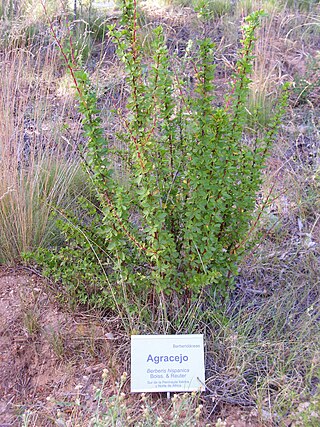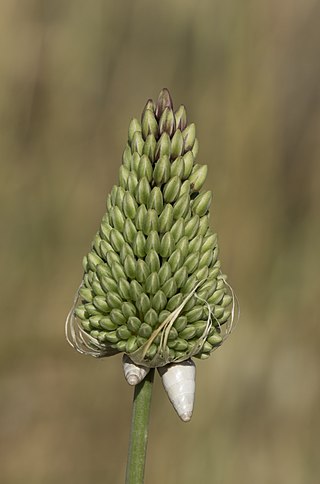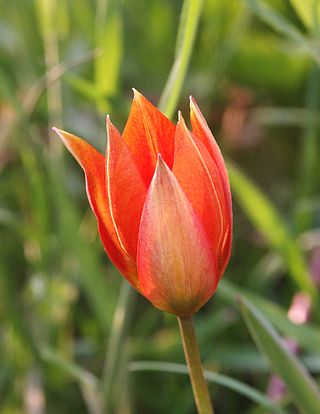
Scilla luciliae is a species of flowering plant in the family Asparagaceae. It is referred to by the common names Bossier's glory-of-the-snow or Lucile's glory-of-the-snow, and is a bulbous perennial from western Turkey that flowers in early spring. After flowering, it goes into dormancy until the next spring. The specific epithet is in honour of Lucile, the wife of the Swiss botanist Pierre Edmond Boissier (1810-1885). It belongs to a group of Scilla species that were formerly put in a separate genus, Chionodoxa, and may now be treated as Scilla sect. Chionodoxa.
Microsciadium is a monotypic genus of flowering plants in the family Apiaceae. Its sole species is Microsciadium minutum, native to the eastern Aegean Islands and Turkey. The genus was first described by Pierre Edmond Boissier in 1844. The species was first described in 1822 as Cuminum minutum.

Heinrich Carl Haussknecht was a German pharmacist and botanical collector who was a native of Bennungen, Sachsen-Anhalt.

Halothamnus lancifolius is a species of the plant genus Halothamnus, that belongs to the subfamily Salsoloideae within the family Amaranthaceae,. It occurs in Southwest Asia.

Soda stocksii is a shrub species of the family Amaranthaceae.
Colchicum lingulatum is a species of flowering plant in the Colchicaceae family. It is native to north-western Turkey and to Greece. Colchicum lingulatum blooms in early autumn, with pink flowers approximately 3–4 cm in size, with widely spaced petals. The stamens are a prominent yellow. The foliage begins to grow after the flowers.

Berberis vulgaris subsp. australis, synonym Berberis hispanica, is a shrub belonging to the family Berberidaceae and the genus Berberis. It is a woody plant and parts of the plant are considered toxic, although the berries are edible and juicy.

Allium libani is a species of wild bulbous plant geophyte of the genus Allium, belonging to the family of Amaryllidaceae. Allium libani is endemic to the Middle East in Lebanon and Syria.

Allium curtum is species of flowering plant in the amaryllis family, Amaryllidaceae. It is native to Cyprus, Egypt, Lebanon, Palestine, the Sinai Peninsula, Syria and Turkey. It is a bulb-forming perennial producing a tight, head-like umbel of green or purple flowers.
Allium stocksianum is a species of flowering plant in the Amaryllidaceae family. It is native to Pakistan, Afghanistan and Iran. It is a perennial herb up to 15 cm tall, with a bulb up to 20 mm across. Umbels are hemispherical, up to 5 cm across, with pink to purple flowers.
Allium umbilicatum is a species of flowering plant in the family Amaryllidaceae. It is a wild onion native to Pakistan, Afghanistan, Turkmenistan, Uzbekistan, Iran, and Tajikistan. It is a herbaceous perennial up to 40 cm tall, with an egg-shaped bulb up to 15 mm long. The leaves are tubular. The umbels are hemispherical and densely crowded with many pink flowers.
Allium frigidum is a species of flowering plant in the family Amaryllidaceae. It is endemic to Greece.
Allium cassium is a species of flowering plant in the Amaryllidaceae family. It is a wild onion native to Turkey, Lebanon, Israel, and Cyprus.

Fritillaria crassifolia is a Middle Eastern species of bulb-forming flowering plant in the lily family Liliaceae, native to Iran, Iraq, Turkey, Syria, and Lebanon.

Fritillaria gibbosa is a species of herbaceous perennial plant in the lily family Liliaceae. It is native to Afghanistan, Iran, Pakistan, Turkmenistan, and Transcaucasia.
Gagea amblyopetala is a Eurasian species of plants in the lily family, Liliaceae. It is native to the Aegean Islands, Albania, Crete, Crimea, Greece, Italy, Sicily, Turkey, Yugoslavia. It is a bulb-forming perennial with yellow flowers.

Tulipa orphanidea is a species of flowering plant in the Liliaceae family. It was described by Pierre Edmond Boissier and Theodor Heinrich Hermann von Heldreich (1862).
Digitalis cariensis is a species of flowering plant in family Plantaginaceae. It is a type of foxglove. It is native to southwestern to southern Turkey.
Turgeniopsis is a monotypic genus of flowering plants belonging to the family Apiaceae. It contains only one known species, Turgeniopsis foeniculacea. The earlier synonym Glochidotheca is also used as the accepted genus name, but Plants of the World Online states that it was not validly published.
Petroedmondia is a monotypic genus of flowering plants belonging to the family Apiaceae. It only contains one known species, Petroedmondia syriaca.









